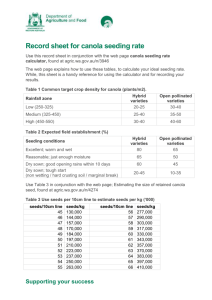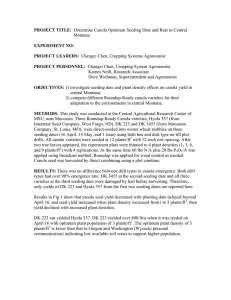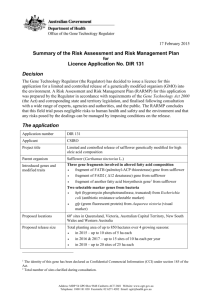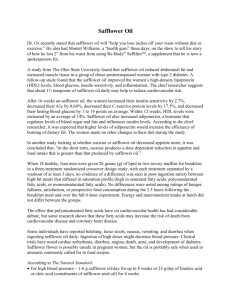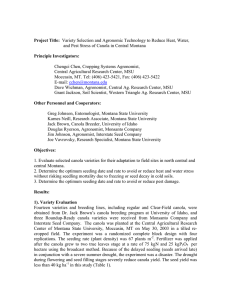Document 13474759
advertisement
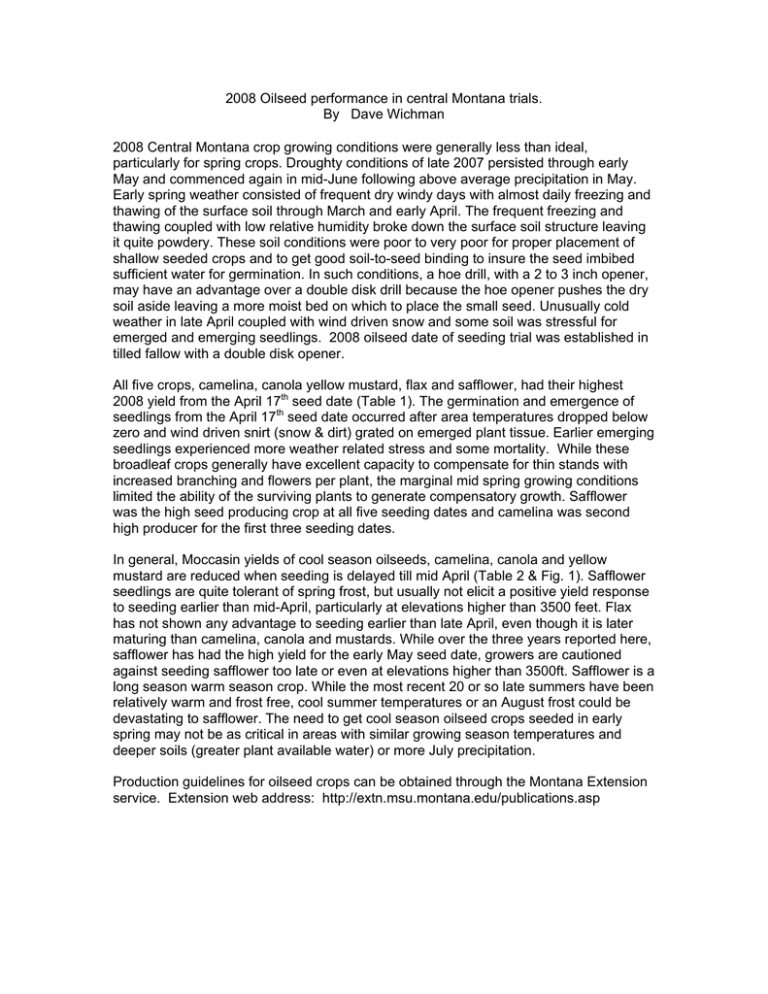
2008 Oilseed performance in central Montana trials. By Dave Wichman 2008 Central Montana crop growing conditions were generally less than ideal, particularly for spring crops. Droughty conditions of late 2007 persisted through early May and commenced again in mid-June following above average precipitation in May. Early spring weather consisted of frequent dry windy days with almost daily freezing and thawing of the surface soil through March and early April. The frequent freezing and thawing coupled with low relative humidity broke down the surface soil structure leaving it quite powdery. These soil conditions were poor to very poor for proper placement of shallow seeded crops and to get good soil-to-seed binding to insure the seed imbibed sufficient water for germination. In such conditions, a hoe drill, with a 2 to 3 inch opener, may have an advantage over a double disk drill because the hoe opener pushes the dry soil aside leaving a more moist bed on which to place the small seed. Unusually cold weather in late April coupled with wind driven snow and some soil was stressful for emerged and emerging seedlings. 2008 oilseed date of seeding trial was established in tilled fallow with a double disk opener. All five crops, camelina, canola yellow mustard, flax and safflower, had their highest 2008 yield from the April 17th seed date (Table 1). The germination and emergence of seedlings from the April 17th seed date occurred after area temperatures dropped below zero and wind driven snirt (snow & dirt) grated on emerged plant tissue. Earlier emerging seedlings experienced more weather related stress and some mortality. While these broadleaf crops generally have excellent capacity to compensate for thin stands with increased branching and flowers per plant, the marginal mid spring growing conditions limited the ability of the surviving plants to generate compensatory growth. Safflower was the high seed producing crop at all five seeding dates and camelina was second high producer for the first three seeding dates. In general, Moccasin yields of cool season oilseeds, camelina, canola and yellow mustard are reduced when seeding is delayed till mid April (Table 2 & Fig. 1). Safflower seedlings are quite tolerant of spring frost, but usually not elicit a positive yield response to seeding earlier than mid-April, particularly at elevations higher than 3500 feet. Flax has not shown any advantage to seeding earlier than late April, even though it is later maturing than camelina, canola and mustards. While over the three years reported here, safflower has had the high yield for the early May seed date, growers are cautioned against seeding safflower too late or even at elevations higher than 3500ft. Safflower is a long season warm season crop. While the most recent 20 or so late summers have been relatively warm and frost free, cool summer temperatures or an August frost could be devastating to safflower. The need to get cool season oilseed crops seeded in early spring may not be as critical in areas with similar growing season temperatures and deeper soils (greater plant available water) or more July precipitation. Production guidelines for oilseed crops can be obtained through the Montana Extension service. Extension web address: http://extn.msu.montana.edu/publications.asp Table 1 2008 Oilseed date of seeding evaluation under tilled fallow. Exp 66dt08 Central Agricultural Research Center. Moccasin, Montana. Seed Plant Test Oil Variety Species Seed Date Yield Height Weight Content lbs/a cm lb/bu % Suneson camelina 23-Mar-08 607 71.0 51.4 38.7 Suneson camelina 7-Apr-08 1042 69.5 51.8 38.4 Suneson camelina 17-Apr-08 1186 64.5 51.9 40.3 Suneson camelina 2-May-08 371 63.5 51.7 35.2 Suneson camelina 16-May-08 267 58.5 51.2 35.1 Pennant yel. mustard 23-Mar-08 242 41.8 55.5 30.7 Pennant yel. mustard 7-Apr-08 760 54.3 55.4 30.1 Pennant yel. mustard 17-Apr-08 1074 54.2 55.5 29.2 Pennant yel. mustard 2-May-08 359 53.5 56.1 28.4 Pennant yel. mustard 16-May-08 190 47.8 55.0 28.1 RR357 canola 23-Mar-08 290 66.8 48.2 46.3 RR357 canola 7-Apr-08 723 61.0 49.2 45.5 RR357 canola 7-Apr-08 569 71.5 49.6 45.1 RR357 canola 2-May-08 377 66.2 50.1 43.5 RR357 canola 16-May-08 176 66.5 48.5 44.6 Omega flax 23-Mar-08 97 50.5 39.3 Omega flax 7-Apr-08 201 53.0 40.2 Omega flax 17-Apr-08 227 58.8 39.4 Omega flax 2-May-08 218 47.2 39.8 Omega flax 16-May-08 175 45.5 39.7 Nutrasaf safflower 23-Mar-08 1216 59.0 37.2 47.1 Nutrasaf safflower 7-Apr-08 1280 60.5 37.0 46.2 Nutrasaf safflower 7-Apr-08 1136 60.2 36.2 45.73 Nutrasaf safflower 2-May-08 901 64.8 35.3 44.02 Nutrasaf safflower 16-May-08 731 55.5 33.5 40.2 mean 576.6 58.61 CV1 14.56 8.678 LSD (0.05) 137.3 8.316 Table 2 Species Camelina Oilseed species yield response to seeding date. Central Agricultural Research Center. Moccasin, Montana. early mid late- April Year April April early- May lbs/a lbs/a lbs/a 2006 1189 1146 716 2007 821 902 665 2008 1042 1186 371 mean 1017 1078 584 Canola 2006 2007 2008 mean 552 778 723 684 380 527 569 492 437 69 377 294 Yellow Mustard 2006 2007 2008 mean 999 715 760 825 527 504 1074 702 494 298 359 384 Flax 2006 2007 2008 mean 509 575 201 428 510 583 227 440 540 524 218 427 Safflower 2006 2007 2008 mean 633 426 1280 780 581 492 1136 736 575 631 901 702 736.3 656.6 447.7 Overall mean Fig 1. 2006 to 2008 seeding date affect on oilseed crop seed yields at the Central Ag Research Center. 1200 Camelina Canola Y.Mustard Flax Safflower Seed Yield (lbs/a) 1000 800 600 400 200 0 early Table 3 mid Early April to early May seeding dates late High yields of seven oilseed species in central Montana. Central Agricultural Research Center. Moccasin, Montana Fallow No-till Continuous Crop Species 2004 2005 2006 2007 2008 average 2007 2008 1/ lbs/a lbs/a f/ Camelina 1028 868 1262 902 825 977 2381 1186 Canola 533 668 555 777 734 653 723 f/ Y.mustard 512 999 715 784 753 1074 B.juncea 534 613 573 531 Crambe 488 408 459 452 f/ 566 227 Flax 579 745 574 583 348 Safflower 605 1049 693 631 505 697 1280 f /data point is from a production field sample The variety used may not have the highest yield potential for that species. 1/ March- April 2008 sifting soil & severe cold reduced fallow oilseed stands. June 10th hail beat the 2008 fallow oilseeds to the ground.

